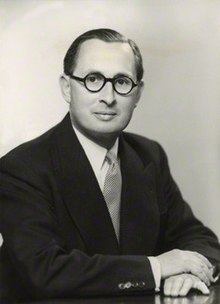Basil Smallpeice
|
Sir Basil Smallpeice KCVO |
|
|---|---|
 |
|
| Born |
September 18, 1906 Rio de Janeiro, Brazil |
| Died | July 12, 1992 (aged 85) Epsom, Surrey |
| Nationality | British |
| Education | University of London |
| Occupation | Company director |
| Board member of |
British Overseas Airways Corporation (1953–1963) Cunard Line (1964–1971) Trafalgar House (1971–1972) Lonrho (1972–1973) |
| Spouse(s) | Kathleen Singleton (1931–1973) (her death) Rita Burns (1973–1992) (his death) |
Sir Basil Smallpeice KCVO (18 September 1906 – 12 July 1992) was a British accountant and businessman, who served as a director of several British companies, including the state owned airline British Overseas Airways Corporation (BOAC), the shipping company Cunard and the mining based conglomerate Lonrho.
Smallpeice, as financial comptroller and later, managing director, was one of the board of BOAC who was instrumental in purchasing and introducing jet powered aircraft into passenger service. He was responsible for the purchase of the de Havilland Comet, the Boeing 707 and the Vickers VC10. His time at BOAC included the introduction of the Comet 1, the subsequent Comet disasters where metal fatigue caused the in-flight destruction of three aircraft, with a loss of 99 passengers and crew, the re-introduction of the Comet 4 and the inauguration of the first jet-powered transatlantic services in October 1958. He would later be instrumental in the purchase of the Boeing 707, which introduced the first by-pass turbofan engine, the Rolls-Royce Conway into passenger service. He left BOAC along with his chairman Matthew Slattery, over disagreements with the Government concerning financial support in return for purchasing the Vickers VC10.
He moved to Cunard as a director and then chairman, where he was responsible for radically altering the passenger and freight operations of the business; on the passenger side of the business, he cut massive losses by selling the Queen Mary and Queen Elizabeth liners, then oversaw the radical re-design of the replacement liner the Queen Elizabeth 2, which was under construction when he took up his position with Cunard. The changes he oversaw allowed the Queen Elizabeth 2 to become a profitable luxury liner for the company. His work on the freight size of the business included the containerisation of the business together with the amalgamation of smaller lines and the formation of joint ventures which would be needed to operate larger container ships. He was chairman of Cunard when the Atlantic Conveyor was ordered and launched as part of Cunard's contribution to the Atlantic Container Line joint-venture.
...
Wikipedia
